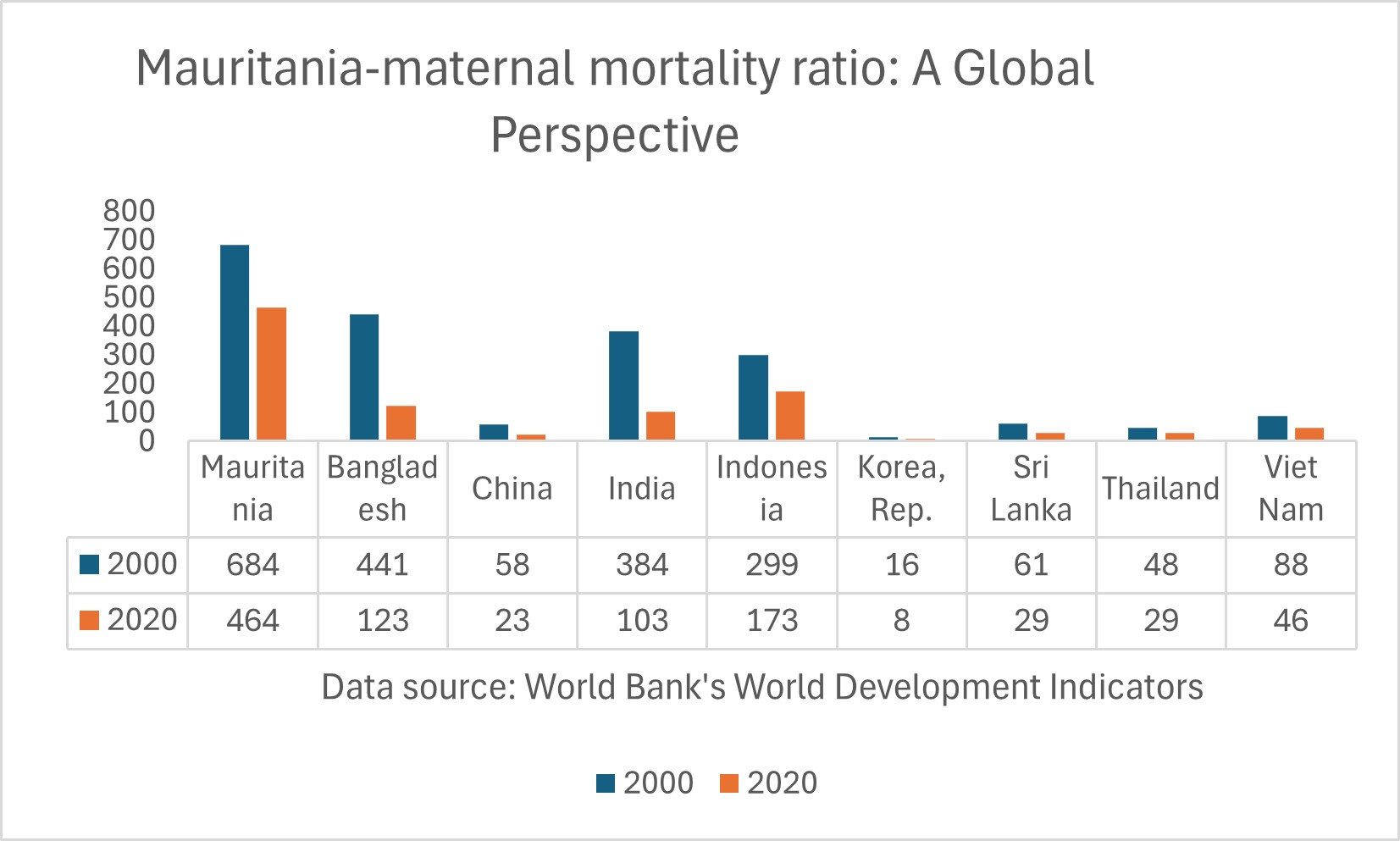
Mauritania
Country Flag Details green with a yellow, five-pointed star between the horns of a yellow, upward-pointing crescent moon; red stripes along the top and bottom edges; the crescent, star, and color green are traditional symbols of Islam; green also represents hope for a bright future; the yellow color stands for the sands of the Sahara; red symbolizes the blood shed in the struggle for independence.
Background The Amazigh and Bafour people were
among the earliest settlers in what is now
Mauritania. The country gained
independence from France in 1960. After
years of dictatorships, flawed elections, and
military coups, the country is now an
emerging democracy.
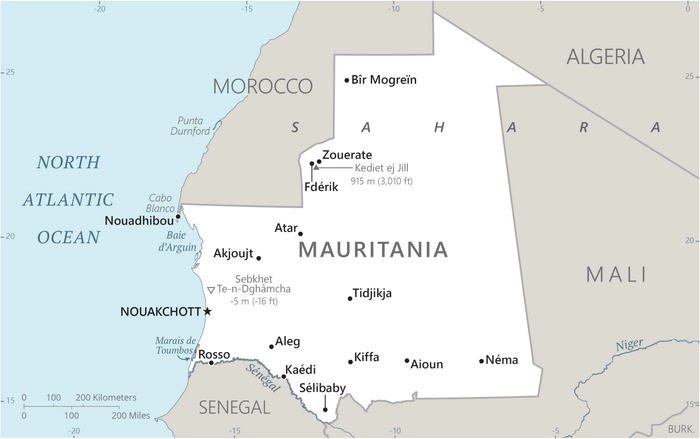
Geography
Area
total : 1,030,700 sq km
land: 1,030,700 sq km
water: 0 sq km
Climate
desert; constantly hot, dry, dusty
Natural resources
iron ore, gypsum, copper, phosphate,
diamonds, gold, oil, fish
People and Society
Population
total: 4,328,040
Ethnic groups
Black Moors (Haratines – Arabic-speaking
descendants of African origin who are or
were enslaved by White Moors) 40%, White
Moors (of Arab-Amazigh descent, known as
Beydane) 30%, Sub-Saharan Mauritanians
(non-Arabic speaking, largely resident in or
originating from the Senegal River Valley,
including Halpulaar, Fulani, Soninke, Wolof, and Bambara ethnic groups) 30%
Languages
Arabic (official and national), Pular, Soninke, Wolof (all national languages), French Religions
Muslim (official) 100%
Population growth rate
1.92% (2024 est.
Government
Government type
presidential republic
Capital name: Nouakchott
Executive branch
chief of state: President Mohamed Ould
Cheikh el GHAZOUANI (since 1 August
2019)
head of government: Prime Minister Moctar Ould DIAY (since 2 August 2024)
Economy
Real GDP (purchasing power parity)
$31.434 billion (2023 est.)
$29.514 billion (2022 est.)
$27.635 billion (2021 est.)
Real GDP per capita
$6,300 (2023 est.)
$6,100 (2022 est.)
$5,800 (2021 est.)
Exports
$3.955 billion (2023 est.)
$4.132 billion (2022 est.)
$3.18 billion (2021 est.)
Exports – partners
China 25%, Switzerland 14%, Canada 12%,
UAE 9%, Spain 7% (2023)
Exports – commodities
gold, iron ore, fish, processed crustaceans,
copper ore (2023)
Imports
$5.271 billion (2023 est.)
$5.77 billion (2022 est.)
$4.312 billion (2021 est.)
Imports – partners
China 19%, UAE 14%, Morocco 6%, Spain
6%, France 5% (2023)
Imports – commodities
refined petroleum, raw sugar, palm oil,
wheat, soybean oil (2023)

Export structure by product groups in 2023 (% of total export) (UNCTAD)
The export structure of a country is a key indicator that showcases the variety, composition, and value of its internationally traded goods and services, offering vital insights into its economic health and developmental stage. In the case of Mauritania, the export landscape is heavily influenced by its rich resources, predominantly in mining and fishing, where iron ore, gold, and fishery products constitute the majority of the nation’s export revenues. Despite the significant contributions of these sectors to the country’s income, Mauritania is keenly aware of the necessity for diversification. To promote sustainable growth and effectively mitigate potential risks arising from fluctuations in global markets, the country is actively implementing various strategies aimed at broadening its economic base and enhancing its resilience in the face of external challenges.
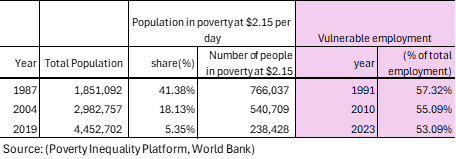
Poverty and vulnerable employment in Mauritania (World Bank)
Understanding poverty level significance at $2.15 per day
In 2019, 5 percent of Mauritania’s population lived in poverty at $2.14 per day. The poverty level at $2.15 per day (measured in 2017 purchasing power parity, or PPP) is a key global benchmark used by the World Bank to define extreme poverty in low-income countries. It indicates:
1. Basic Survival Threshold
• People living below $2.15 per day struggle to afford essential needs such as food, clean water, shelter, healthcare, and education.
2. Economic Underdevelopment
• A high percentage of a country’s population living below this threshold suggests low economic productivity, high unemployment, and weak social safety nets.
3. Inequality and Social Vulnerability
• It reflects deep income inequality and a lack of access to opportunities for upward mobility.
• People in this category are more vulnerable to shocks like food price increases, climate disasters, or health crises.
4. Policy Challenges
• Governments need targeted interventions such as social welfare programs, job creation, and improved access to education and healthcare to reduce poverty.
A country's export structure is a reflection of its level of development and productive capacities
The export structure of a country refers to the composition, diversity, and value of the goods and services it sells to other countries. It provides key insights into the country’s economic health, competitiveness, and level of development. Productive capacities of a country refer to its ability to produce goods and services efficiently and sustainably over time. These capacities are shaped by various factors, including human capital, natural resources, infrastructure, private sector, development, technology & innovation, institutions & governance, financial systems trade & market access.
Here’s what the export structure and productive capacities of a country typically indicate:
- Level of Economic Development
- Developed economies usually export high-value manufactured goods, technology, and services.
- Developing economies often rely on raw materials, agricultural products, or low-value manufactured goods.
- Industrial and Sectoral Strengths
- A strong presence of high-tech or industrial goods (e.g., machinery, electronics) suggests a well-developed manufacturing sector.
- A dominance of commodities (e.g., oil, minerals, agricultural products) indicates reliance on natural resources.
- Export Diversification
- A diverse export base (multiple industries) makes a country’s economy more stable and resilient to global price shocks.
- A concentrated export base (few key products) makes it vulnerable to market fluctuations.
- Trade Partnerships and Dependence
- If exports are heavily dependent on a single country or region, the economy is more exposed to geopolitical and trade risks.
- A wide range of trading partners indicates stronger global integration.
- Competitiveness and Value Addition
- Exporting mainly raw materials (e.g., crude oil instead of refined petroleum) suggests limited industrial processing capacity.
- A high share of finished and high-tech goods suggests strong value addition and competitiveness.
Mauritania-Sanitation
Mauritania – Proportion of population served with at least basic sanitation
In 2022, proportion of population served with at least basic sanitation for Mauritania was 55.9 %. Between 2000 and 2022, proportion of population served with at least basic sanitation of Mauritania grew substantially from 18% in 2000 to 55.9 % in 2022, an absolute change of 37.9 percentage points (pp) between 2000 and 2022.
Mali – Proportion of urban population served with at least basic sanitation
In 2022, proportion of urban population served with at least basic sanitation for Mauritania was 79.3 %. Proportion of urban population served with at least basic sanitation of Mauritania increased from 37.4 % in 2000 to 79.3 % in 2022 an absolute change of 41.9 pp between 2000 and 2022.
Mali – Proportion of rural population served with at least basic sanitation
In 2022, proportion of rural population served with at least basic sanitation for Mauritania was 25 %. Proportion of rural population served with at least basic sanitation of Mauritania increased from 6 % in 2000 to 25 % in 2022, an absolute change of 19 pp between 2000 and 2022.
Mauritania – Proportion of total population served with at least basic sanitation: A Global Perspective
The ongoing lack of safe sanitation is a heartbreaking reality that demands urgent action to protect countless lives each year, highlighting a serious public health crisis we must tackle together. Safe sanitation is a fundamental human right that every individual should have access to without exception. In 2022, about 2 million people, nearly 44 percent of Mauritania’s population, faced the harsh consequences of inadequate sanitation, revealing a stark inequity compared to other nations. For instance, Vietnam, China, and Thailand reported much lower percentages of 8 percent, 5 percent, and just 1 percent without these essential services. The global average of 6 percent without access to sanitation reinforces the pressing need for our collective efforts to enhance sanitation access in the underserved regions of Sub-Saharan Africa.
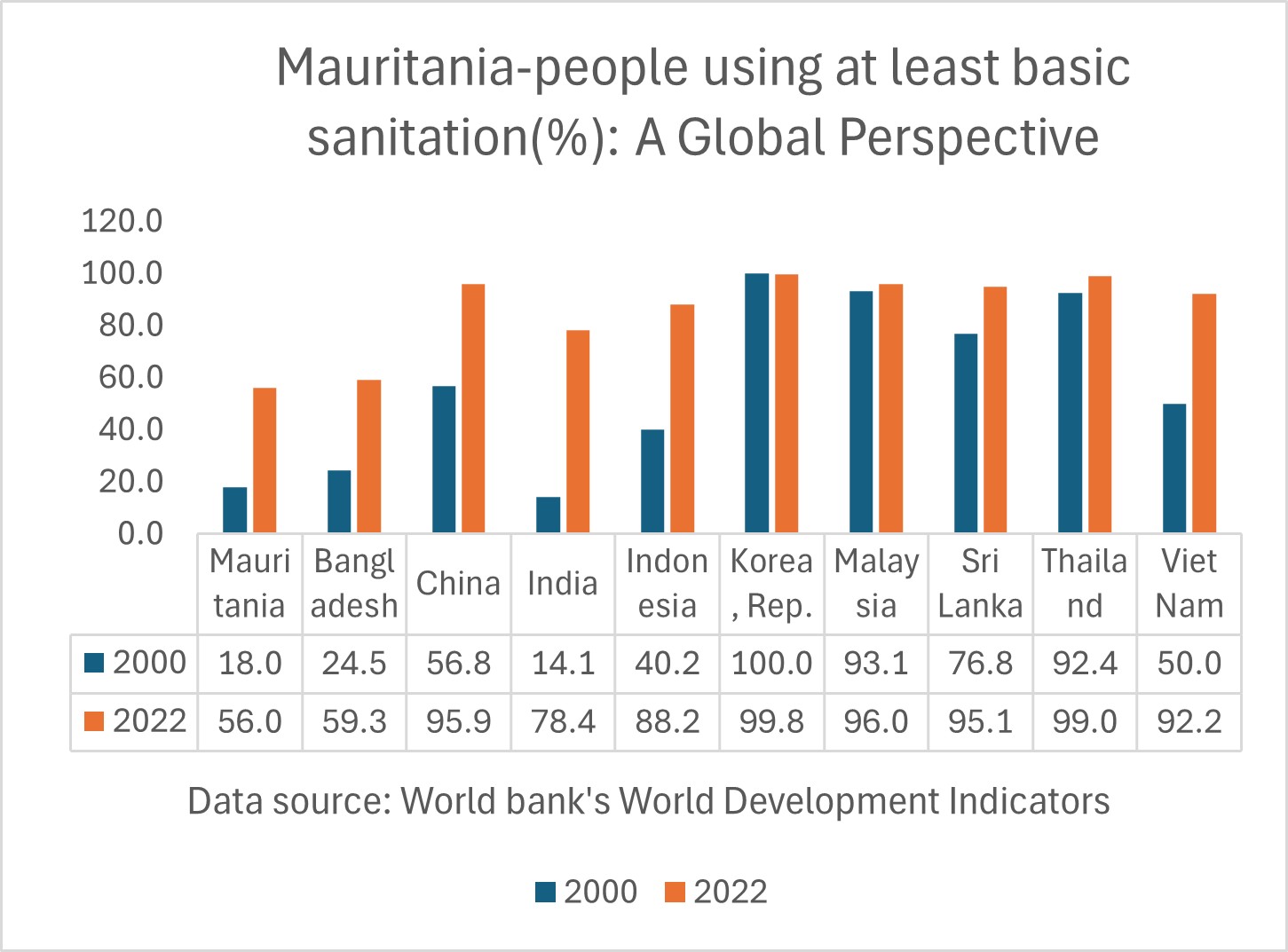
Mauritania – Proportion of rural population served with at least basic sanitation: A Global Perspective
In 2022, nearly one and a half million individuals in rural Mauritania faced the harsh reality of lacking basic sanitation facilities, representing about 75 percent of this population. This alarming situation contrasts starkly with Vietnam, Sri Lanka, and Thailand, where only 12 percent, 5 percent, and 2 percent are similarly affected. The absence of safe sanitation is a critical concern that requires our immediate action, contributing to preventable deaths and highlighting a pressing public health crisis. Recognized as a fundamental human right, access to safe sanitation should be guaranteed for all. It is essential to unite our efforts to advocate for this vital right across Sub-Saharan Africa, where the need is urgent and the potential for transformative community benefits in health and social progress is immense.
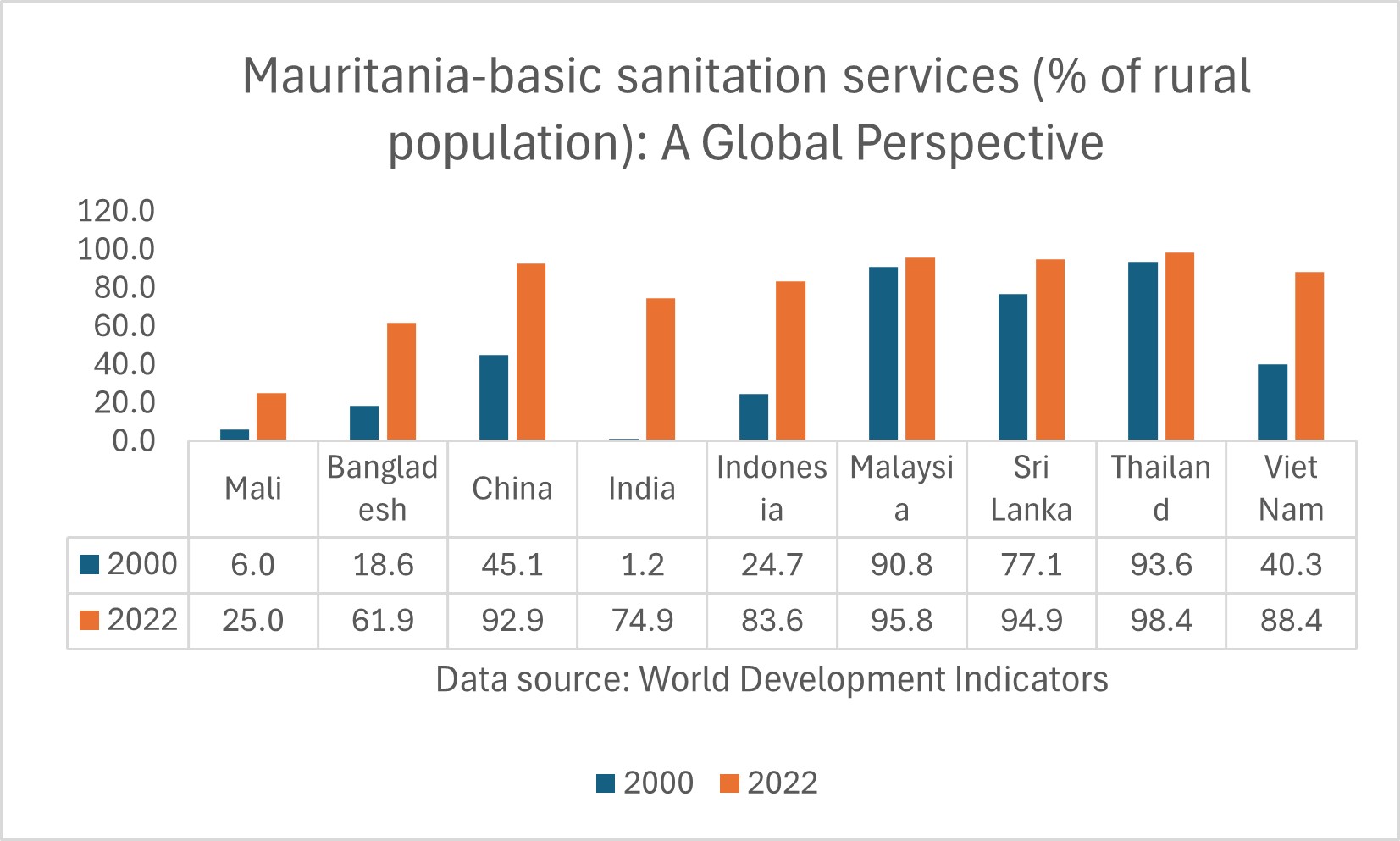
Mauritania-Water Supply
Mauritania – Proportion of total population served with at least basic water
In 2022, proportion of population served with at least basic water for Mauritania was 77.8 %. Proportion of population served with at least basic water of Mauritania increased from 41.7 % in 2000 to 77.8 % in 2022 , an absolute change of 36.1 pp between 2000 and 2022.
Guinea Bissau – Proportion of urban population served with at least basic water
In 2022, proportion of urban population served with at least basic water for Mauritania was 94.6 %. Proportion of urban population served with at least basic water of Mauritania increased from 67.6 % in 2000 to 94.6 % in 2022 an absolute change of 27 between 2000 and 2022.
Mauritania – Proportion of rural population with at least basic water
In 2022, proportion of rural population served with at least basic water for Mauritania was 55.6 %. Proportion of rural population served with at least basic water of Mauritania increased from 25.7 % in 2000 to 55.6 % in 2022, an absolute change of 29.9 pp between 2000 and 2022.
Mauritania – Proportion of total population served with at least basic drinking water: A Global Perspective
It is deeply troubling that in 2022 nearly 1 million individuals in Mauritania, or about 22 percent of the population, lacked access to safe drinking water, highlighting a significant inequality in basic necessities. In contrast, every person in Thailand had access to this vital resource, and 98 percent of the populations in Bangladesh and Vietnam enjoyed the same right. These disparities in water security and public health emphasize that access to safe drinking water is a fundamental human right essential for health and well-being. Urgent action is needed to improve living conditions and ensure equitable access to safe drinking water for vulnerable communities in Sub-Saharan Africa, where the consequences of such inequalities are severe and require immediate intervention.

Mauritania – Proportion of rural population served with at least basic drinking water: A Global Perspective
In 2022, it was alarming to find that 44 percent of the rural population in Mauritania, or about 900 thousand people, lacked access to safe drinking water, a fundamental necessity for health and well-being. This striking disparity is evident when compared to countries like Thailand and Bangladesh, where nearly all rural residents have clean water access. This situation not only highlights the hardships faced by many families in Mauritania but also calls for immediate and compassionate action throughout Sub-Saharan Africa. We must unite to tackle the critical challenges of water accessibility and sustainability, promoting innovative solutions that ensure everyone can access this essential resource, thereby fostering healthier communities and a more sustainable future for all.
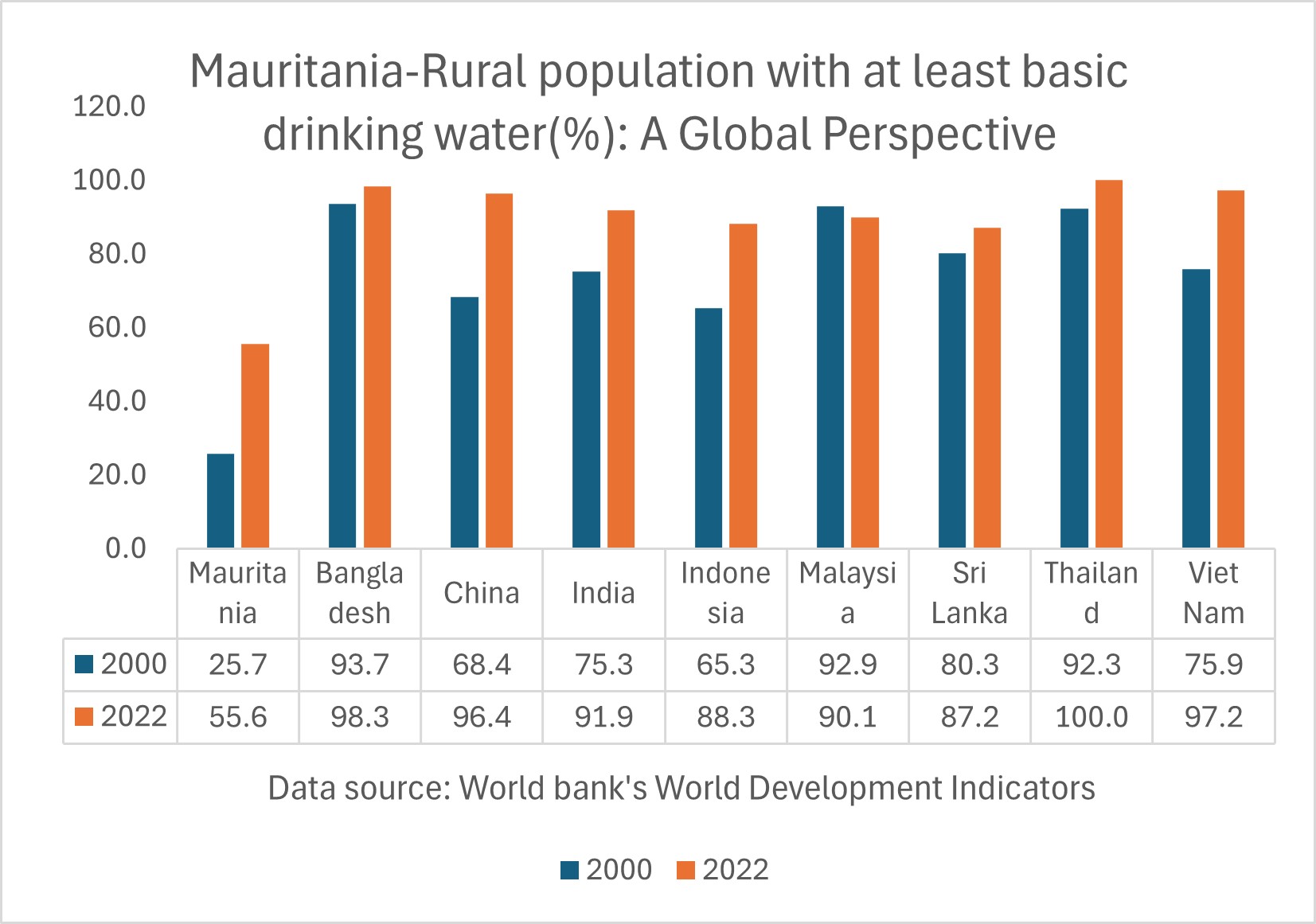
Mauritania-Access to Electricity
Mauritania-Access to electricity (% of population)
In 2022, proportion of population with access to electricity for Mauritania was 49 %. The proportion of population with access to electricity of Mauritania increased from 19.1% in 2000 to 49% in 2022, an absolute change of 29.9 pp, between 2000 and 2022.
Mauritania-Access to electricity (% urban population)
In 2022, proportion of urban population with access to electricity for Mauritania was 91.6%. The proportion of urban population with access to electricity of Mauritania increased from 45.3% % in 2000 to 91.6% in 2022, an absolute change of 46.3 pp, between 2000 and 2022.
Guinea Bissau-Access to Electricity (% rural population)
In 2010, the proportion of rural population with access to electricity for Mauritania was 2.1 % (the latest available data). The proportion of rural population with access to electricity in Mauritania gradually decreased from 3% in 2000 to 2.1 % % in 2010, an absolute change of 0.9 pp, between 2000 and 2010.
Mauritania – Proportion of total population with electricity: A Global Perspective
In 2022 nearly 51 percent of Mauritania’s population lacked access to electricity which underlines a significant inequality that profoundly affects the daily lives and economic prospects of over half of its citizens, creating obstacles that are difficult to overcome. This alarming situation is especially striking when we consider countries like Vietnam, Thailand, Sri Lanka, and Malaysia, which have successfully achieved universal electricity access, showcasing the stark contrasts in development and the urgent need for systemic reforms across Sub-Saharan Africa. The absence of reliable electricity is not merely an inconvenience; it is a substantial barrier to development, health, education, and economic growth, ultimately obstructing improvements in living standards and diminishing the potential for a brighter future for all individuals in these regions.
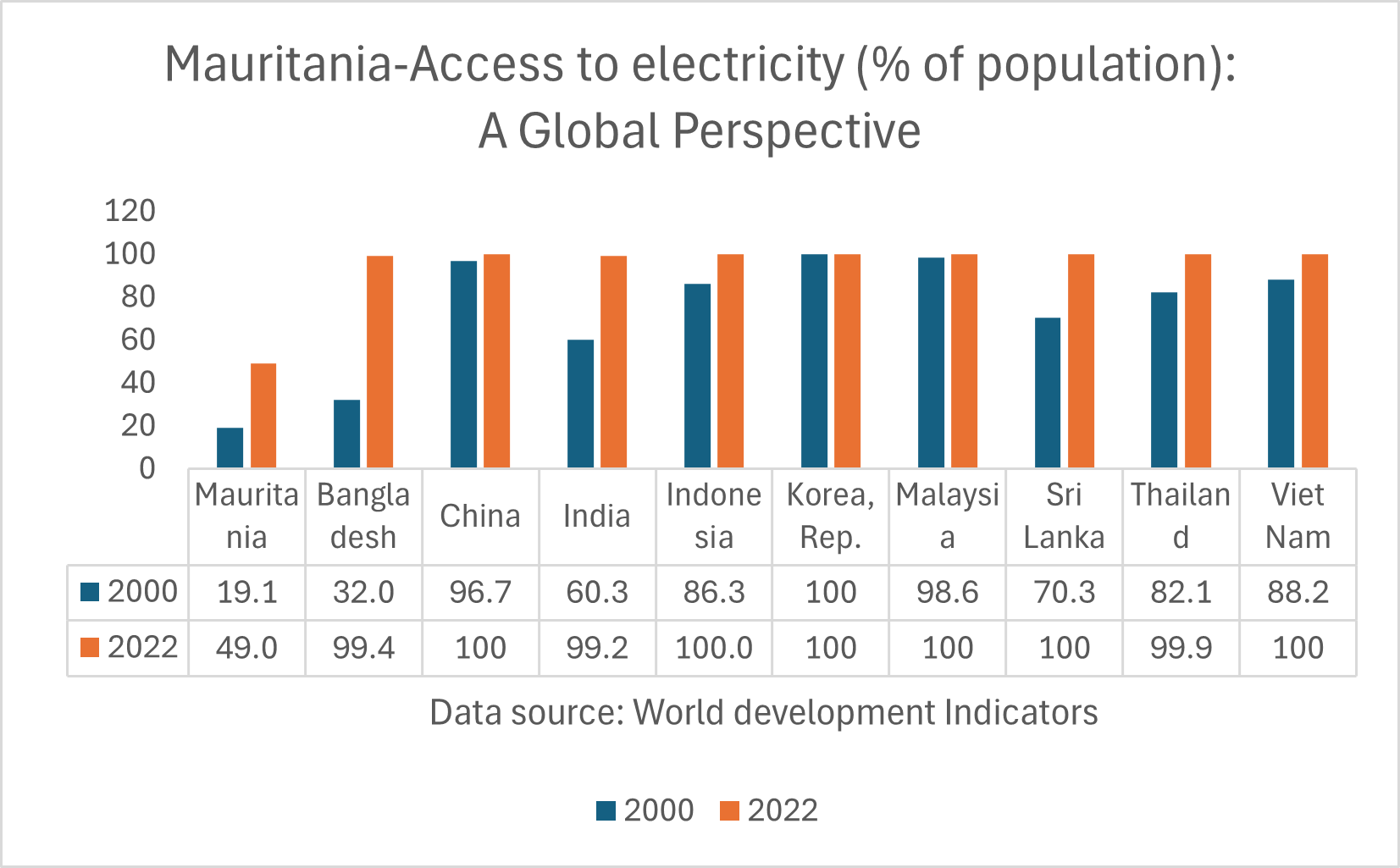
Mauritania – Proportion of rural population with electricity: A Global Perspective
In 2010, a staggering 97.9% of the rural population in Mauritania faced the harsh reality of living without electricity, which vividly highlights a profound disparity compared to countries such as Vietnam, Thailand, and Sri Lanka, where every individual in rural areas enjoys full access to this crucial resource. Even in countries like India and Bangladesh, an impressive 99% of the rural populace has the benefit of electricity in their daily lives, significantly enhancing their quality of life. These figures extend beyond mere statistics; they emphasize the pressing necessity for sincere and transformative reforms in governance throughout Sub-Saharan Africa to ensure that every community is empowered with reliable access to electricity, thus enabling them to thrive, innovate, and progress toward a more sustainable and hopeful future, breaking free from the chains of unavailability and ushering in new opportunities for development and growth.
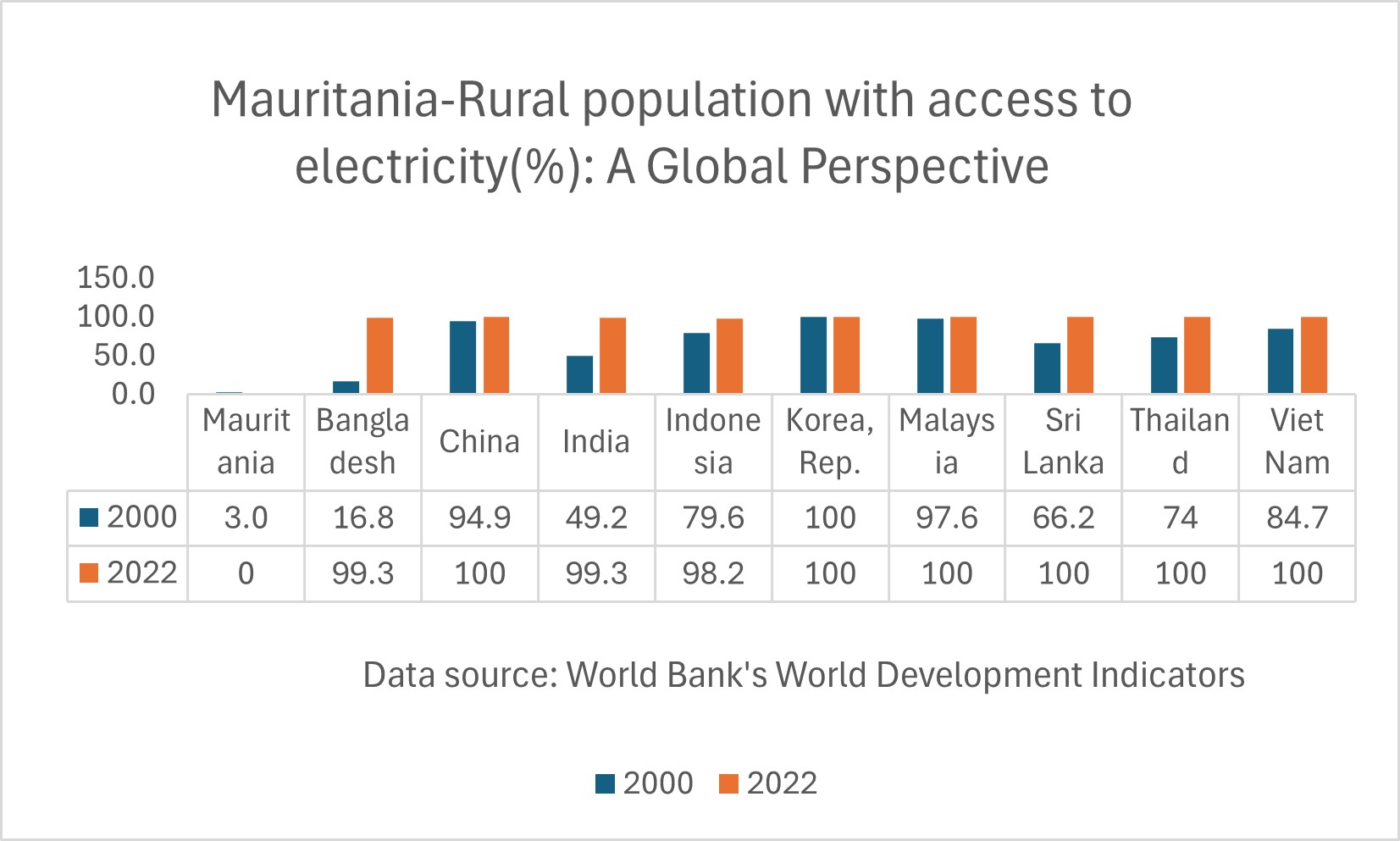
Mauritania-Health outcomes
Mauritania-Life expectancy: A Global Perspective
The analysis of life expectancy trends over the past seventy years reveals that while many populations have experienced increased health and longevity, significant disparities persist, particularly in Sub-Saharan Africa. Globally, average life expectancy for newborns has risen from 47 years in 1950 to 71 years in 2021, yet progress remains alarmingly sluggish in several Sub-Saharan nations. For example, Mauritania’s life expectancy grew from 45 years in 1960 to 65 years in 2022, underscoring the challenges faced by its citizens. In stark contrast, South Korea’s life expectancy surged from 54 years in 1960 to 83 years in 2022, while the Maldives improved from 39 years in 1960 to 81 years in 2022. The persistently low life expectancy in many Sub-Saharan countries highlights the urgent need for transformative action to address chronic poverty, inadequate healthcare, and governance issues, ensuring equitable health advancements for all.

Mauritania-Mortality rate, under-5 (per 1000 live births): A Global Perspective
Since 1950, child mortality rates worldwide have seen a concerning decline, mainly due to improvements in living standards, healthcare access, nutrition, and safe drinking water. In affluent countries in Europe and America, child mortality has plummeted to below 4 percent, highlighting the benefits of strong healthcare systems and socioeconomic stability. Over the last seventy years, many developing nations in South America, Asia, and Africa have made progress, although advancements in Sub-Saharan Africa remain slow and inconsistent. For example, in Mauritania, the under-five mortality rate has decreased from 166 per 1,000 live births in 1980 to 39 in 2022. In contrast, Bangladesh has remarkably reduced its child mortality rate from 206 in 1980 to 29 in 2022, with India achieving a similar decline from 169 to 29 in the same period. These figures reveal ongoing challenges due to inadequate healthcare systems and emphasize the urgent need for structural reforms in governance throughout Sub-Saharan Africa to reduce child mortality and improve health outcomes.
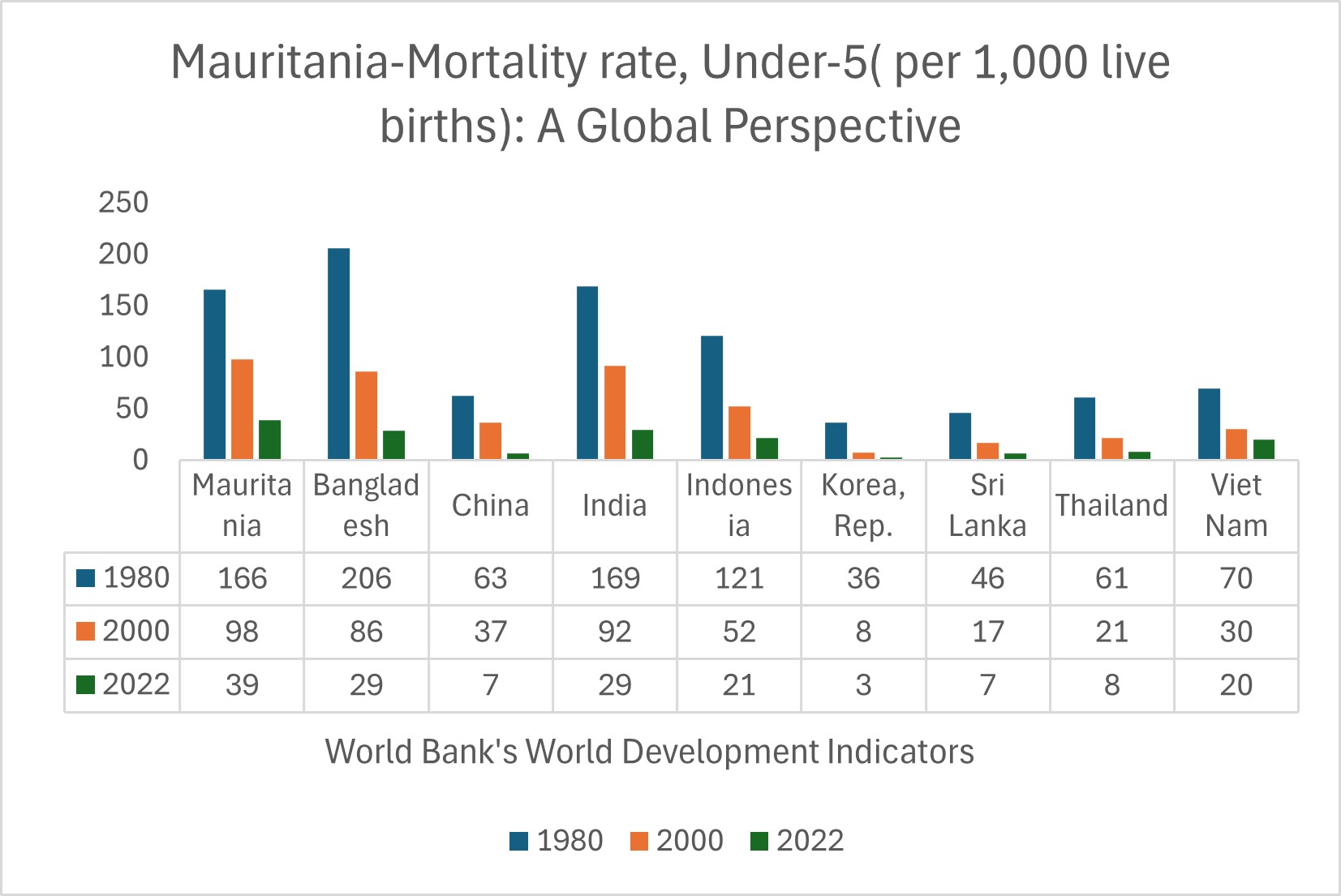
Mauritania-Maternal mortality ratio (per 100,000 live births): A Global Perspective
Mauritania’s maternal mortality ratio, despite a reduction from 684 in 2000 to 464 in 2020, remains alarmingly high, highlighting severe challenges for mothers. This improvement is overshadowed by the maternal mortality ratios of Bangladesh, India, and Vietnam, recorded at 123, 103, and 46 respectively in 2022. The ongoing high maternal mortality rates and elevated birth rate exacerbate the tragic reality that many mothers continue to lose their lives to pregnancy-related complications. These troubling statistics reflect significant deficiencies within the healthcare system and underline the chronic under-resourcing affecting healthcare across Sub-Saharan Africa. The stark contrasts in maternal health outcomes urge the necessity for urgent enhancements in health infrastructure and resources, as the lives of mothers and children in Mauritania remain in jeopardy.
